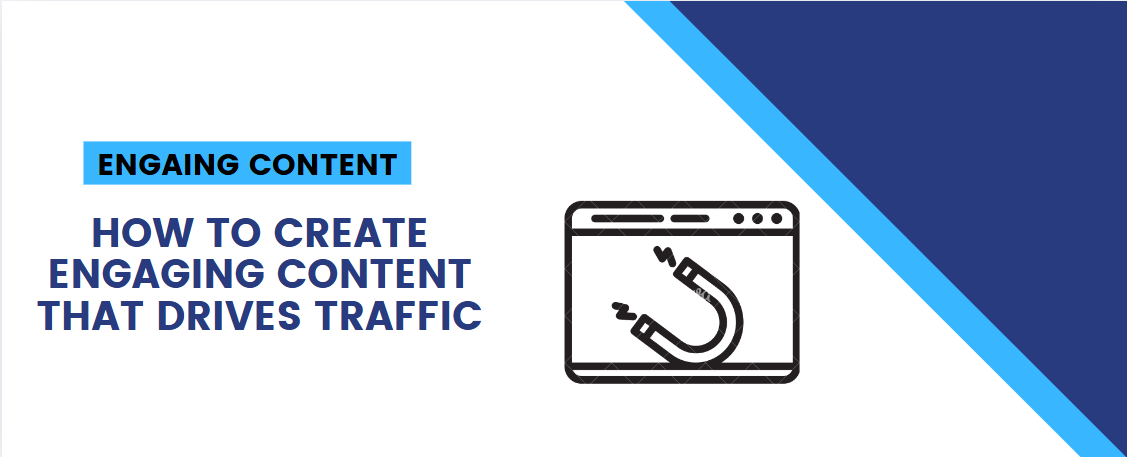Creating engaging content that drives traffic is one of the most powerful strategies you can use to grow your website, blog, or business. But with so much content floating around the internet, how do you stand out? What makes people want to click on your content and keep coming back for more? In this blog post, we’ll break down some simple, actionable steps that can help you create content that not only attracts traffic but also keeps your audience engaged.
Let’s dive in!
Why Engaging Content Matters
Before we get into the “how," let’s quickly talk about why creating engaging content is so important.
You probably know that the internet is full of information—literally millions of blog posts, videos, social media posts, and more. But here’s a surprising stat: over 60% of marketers say that generating traffic and leads is their top challenge. That means even though there’s a ton of content out there, standing out and getting noticed is tough.
Engaging content is the key to solving this problem. When your content is interesting, valuable, and easy to consume, people spend more time on your site, share it with others, and return for more. This helps you increase your organic traffic, boost your SEO rankings, and ultimately grow your business.
Now, let’s look at how you can create this kind of content.
1. Know Your Audience
If you want to create content that resonates with people, you need to know who they are. Understanding your audience helps you create content that speaks directly to their interests, challenges, and needs.

How to do this:
- Create buyer personas: This is a semi-fictional character that represents your ideal audience. Think about things like their age, location, interests, job, and goals. For example, if you run a fitness blog, your buyer persona could be someone interested in losing weight, staying healthy, or getting stronger.
- Use analytics tools: Platforms like Google Analytics, Facebook Insights, and Twitter Analytics provide valuable data about your audience. They can show you demographics (age, gender, location), interests, and behaviors.
- Survey your audience: You can use surveys or polls to ask your readers directly what they like or don’t like. A simple tool like Google Forms or SurveyMonkey can help you get this feedback.
Once you know who you’re talking to, it’s easier to create content that speaks their language and grabs their attention.
2. Write Catchy Headlines
Your headline is the first thing people see. It’s your chance to grab their attention and make them want to click. Studies show that 80% of people only read headlines, and only 20% will go on to read the rest of the content.
Some tips for writing great headlines:
- Make it specific: Instead of a generic headline like “How to Be Healthy," try something more specific like “5 Easy Ways to Eat Healthier Every Day."
- Use numbers: People love listicles, and headlines with numbers tend to get more clicks. For example, “10 Tips for Starting Your Own Business" or “7 Secrets to Staying Motivated."
- Create curiosity: Headlines that leave people curious are more likely to get clicked. A title like “You Won’t Believe What Happened After I Tried This Diet" invites curiosity.
- Use emotional triggers: Words like “amazing," “ultimate," “must-know," or “unbelievable" can increase clicks because they evoke strong emotions.
A tool like CoSchedule’s Headline Analyzer can help you improve your headlines and make them more compelling.
3. Provide Value From the Start
The first few sentences of your content are crucial. If you don’t hook your reader right away, they might bounce off your page and never come back. You have to make it clear why your content is worth their time.
How to hook readers:
- Ask a question: Start with a question that relates to your audience’s problems or needs. For example, “Struggling to lose weight? Here’s how you can get back on track."
- Share a shocking statistic: People love surprising facts. For example, “Did you know that 70% of small businesses fail within the first 5 years?"
- Tell a story: Start with a short, relatable story. A story about overcoming a challenge or achieving a goal can draw readers in and keep them interested.
The goal is to make sure your readers know right away that they’ll get something valuable from reading the entire post.
4. Focus on Quality, Not Quantity
It’s easy to think that the more content you produce, the better. But the truth is, quality trumps quantity. Readers (and search engines like Google) care more about well-researched, high-quality content than the number of blog posts you publish.

In fact, a study by HubSpot found that companies that blog regularly (at least 16 posts a month) get 3.5 times more traffic than those who blog less frequently. But this doesn’t mean you should just churn out blog posts for the sake of it.
What makes quality content?
- Well-researched: Your content should provide real value. If you’re writing about a complex topic, do the research and back up your claims with data and facts. For example, instead of just saying “Content marketing is effective," back it up with data like “According to Content Marketing Institute, 70% of marketers report that content marketing generates more leads than paid search."
- Original: Don’t just copy what everyone else is doing. Offer fresh perspectives and new insights. Google also loves original content and will rank it higher.
- Well-written and easy to read: Make sure your content is clear, concise, and easy to follow. Short paragraphs, bullet points, and subheadings can make your content more scannable.
Remember, Google rewards content that provides value. According to Backlinko, the average length of a top-ranking blog post on Google is around 2,450 words. This doesn’t mean you should write excessively long posts just for the sake of it, but it’s a good reminder that in-depth content performs better.
5. Use Visuals to Enhance Your Content
Visuals like images, infographics, videos, and charts can make your content more engaging and easier to digest. In fact, articles with images get 94% more views than those without. People process visuals 60,000 times faster than text, which means images can help readers understand and remember your message more effectively.

Here’s how you can use visuals:
- Include images: Use relevant images that complement your content. They can break up long paragraphs and keep readers engaged.
- Create infographics: Infographics are great for summarizing information in a visually appealing way. Tools like Canva or Piktochart make it easy to create your own.
- Embed videos: Videos can increase engagement and time on site. If you’re explaining a complex topic, a tutorial video can be incredibly useful.
- Use charts and graphs: If you have data, present it visually. People love seeing statistics in an easy-to-read format.
6. Optimize for SEO
SEO (Search Engine Optimization) is the practice of optimizing your content so that it ranks higher in search engines like Google. When your content ranks well, it can attract a ton of organic traffic.

Here’s what you can do to optimize your content for SEO:
- Use keywords: Research the keywords your audience is searching for using tools like Google Keyword Planner or Ubersuggest. Use these keywords naturally in your headlines, subheadings, and body text.
- Write for featured snippets: Featured snippets are the boxed information that appears at the top of some search results. To optimize for them, structure your content in a question-answer format.
- Optimize images: Don’t forget to use descriptive alt text for images, as this can help improve your SEO rankings.
- Include internal and external links: Linking to other content on your site (internal links) and to authoritative sources (external links) can help boost your SEO.
According to Ahrefs, websites that have a solid SEO strategy are likely to get 6 times more traffic than those that don’t.
7. Promote Your Content
Creating great content is only half the battle. You also need to promote it. You can have the best article in the world, but if no one sees it, it won’t drive traffic.

Here are some ways to promote your content:
- Share on social media: Post your content on all your social media platforms (Facebook, Twitter, LinkedIn, Instagram, etc.). Use attention-grabbing captions and images to get more clicks.
- Email marketing: Send your content to your email list. Email marketing has one of the highest ROI of any marketing channel—42% of marketers say it’s their most effective tactic.
- Collaborate with influencers: Partnering with influencers or other bloggers in your niche can help amplify your content’s reach. They can share your content with their followers, bringing you more traffic.
Conclusion
Creating engaging content that drives traffic requires a mix of strategy, creativity, and persistence. By knowing your audience, writing catchy headlines, providing value, and focusing on quality over quantity, you’ll set yourself up for success. Don’t forget to use visuals, optimize for SEO, and promote your content to make sure it reaches as many people as possible.
Remember, content creation is a long-term game. Be patient, keep improving, and you’ll see the results over time.
Happy content creating!


